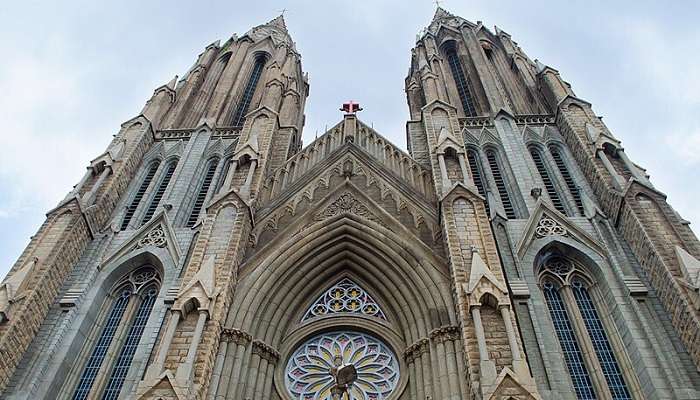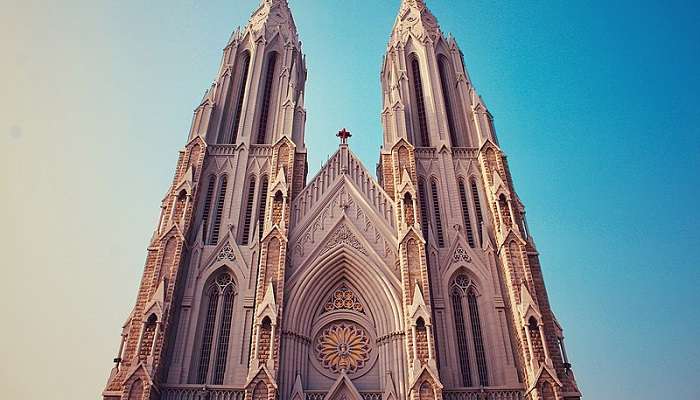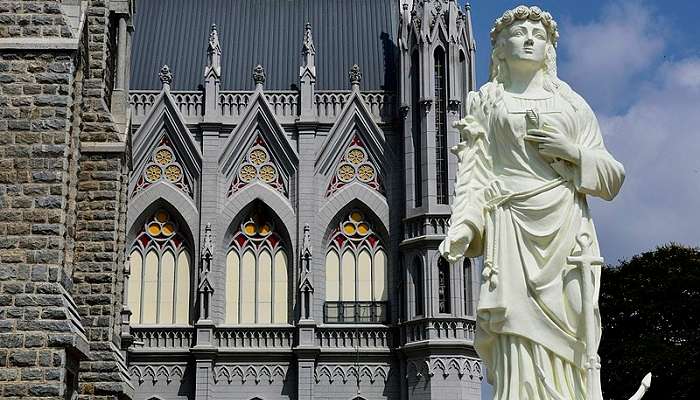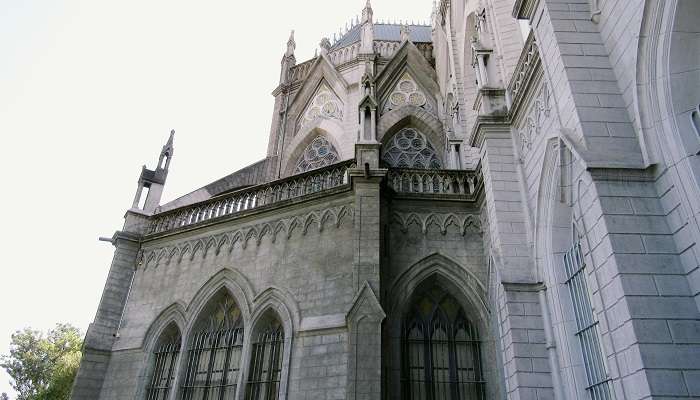Discover The Wonders Of St Philomena’s Cathedral In Mysore In 2026

For centuries, churches have been more than a place of worship. They signify and elevate our faith, hold importance for cultural activities and act as a place of peacefulness and social and charitable roles. One such historic and iconic church is the St Philomena’s Cathedral. The place offers not just serenity but awe-inspiring ancient architectural inspirations, too. And there is so much more to see, discover and know about this fantastic cathedral. The church beckons you to a great touring experience from its essential setting to a prominent location. So, let’s get to know it all and dwell deeper into its history, architecture and much more.
Overview Of The St Philomena’s Cathedral

One of the biggest churches in India, St Philomena’s Church, was initially constructed in 1843 to cater to the British officers based in Srirangapatna and Mysore. Before blueprints for a new, imposing construction were established in 1933, it was first a modest, wooden building that stood for over a century. The church was created in 1936 and modelled after the Cologne Cathedral in Germany. It was designed in the Neo-Gothic style by French architect Daly.
Located on the northern outskirts of the town, St Philomena’s Cathedral is symbolised by the towering structure and the wonderfully stained-glass windows. It is dedicated to the Greek Saint Philomena, born in the 4th Century. A part of her bones and clothes are still kept in the church. The inspiration for the church comes from St. Patrick’s in New York. King Krishanaraja Wodeyar IV laid the foundation of the cathedral. There are beautiful paintings inside that depict the life of Jesus Christ. Christ’s birth and Baptism are also showcased in a highly artful form inside the church.
Must Read: Kesare
St Philomena’s Cathedral History

The history of St Philomena’s Cathedral is as fascinating as its architecture. Earlier in 1843, a church was built at the site where the St. Philomena’s Cathedral resides today. Maharaja Mummadi Krishnaraja built this earlier version. Later, in 1926, Sir T.Thumboo Chetty, then the Huzur Secretary to the King of Mysore, got a relic of St. Philomena from Peter Pisani, the Apostolic Delegate of East India Company. The relic was then passed on to Father Cochet. He then asked the king to build a church honouring St. Philomena. The king agreed, and the church’s foundation was laid on October 28, 1933. This new church was built on divine compassion and human gratitude. The Bishop Rene Feuga supervised the entire construction of the church. The St. Philomena’s relic was kept in the catacomb below the chief altar.
Some believe the cathedral was constructed as a gift for the numerous European residents in Mysuru. The then-king of Mysore, Krishnarajendra Wodeyar, laid the cornerstone for this new church in October 1933 as the rising European population made a larger church necessary. French architect Daly inspired St. Philomena’s Cathedral to imitate Germany’s Cologne Cathedral.
St Philomena’s Cathedral Architecture

Frenchman Daly was the mind behind the church’s design and architecture. The Cologne Cathedral inspired the design, which called for construction in the Neo-Gothic style. The cathedral’s layout is shaped like a cross. The nave, or congregation hall, is the extended portion of the cross. The transepts are the two limbs of the cross. The crossing is the area that houses the choir and the altar. The floor plan of St. Philomena’s Cathedral imitates a cross. The cathedral’s congregation hall is in the nave, the long part of the cross. The transepts are the two limbs of the cross. In the crossing are the choir and the altar.
Within the cathedral’s crypt is a statue dedicated to St. Philomena. The church’s twin spires are 175 feet (53 metres) high and are reminiscent of the spires of St. Patrick’s Church in New York City and the spires of the Cologne Cathedral. Up to 800 people can be seated in the main hall (nave), with stained glass windows showing images from Christ’s birth, the Last Supper, the Crucifixion, the Resurrection and the Ascension. It is thought to be the second-biggest church in Asia.
Suggested Read: Sand Museum Mysore
Everything Else About Saint Philomena

Saint Philomena was a martyr of the Roman Catholic Church and a Latin Catholic Saint. Born in the fourth century, she was a martyred young Greek princess. On May 24, 1802, the bones of a teenage girl, no older than fourteen, were found in Rome’s Catacombs of Saint Priscilla, located on the Via Salaria. These remnants were accompanied by a series of tiles with a broken inscription that read, “LUMENA PAXTE CUM FI”, in an unclear order. The new arrangement of the letters read “PAX TECUM FILUMENA”, which means Peace with you, Filumena in Latin.
In addition, a container containing dry blood and several symbols representing her martyrdom were discovered in the grave. Based on these findings, it was determined that Philomena, a Christian, was interred in the tomb and that the blood-filled vase was likely her relic, signifying her martyrdom. Interestingly, all we know about Saint Philomena is from the vision of a Neapolitan nun. It is believed that the Philomena appeared to Sister Maria Luisa di Gesu and revealed that she was the daughter of a Greek monarch who became a Christian. Philomena made a consecrated virginity vow when she was thirteen years old.
Interesting Facts

St. Philomena’s Cathedral is also locally called the Cathedral of Mysore Diocese. The cathedral is also known as St. Joseph’s Cathedral, even though its full name is the Cathedral of St. Joseph and St. Philomena. Every day, in the sanctum sanctorum of St. Philomena’s Cathedral, Holy Mass is recited in Kannada, Tamil and English. Beneath it stands an idol of Jesus Christ bearing his sacred wounds and a statue of St. Philomena. The cathedral’s spires, which stand at around 175 feet, are reminiscent of St. Patrick’s Church in New York and the Cologne Cathedral in Germany.
Beneath the main altar of St. Philomena’s Cathedral is a lovely catacomb dedicated to St. Philomena. One of the oldest cathedrals in India, St. Philomena’s Cathedral in Mysore, dates back more than 200 years. There was a tiny church in this exact spot around 250 years ago. Today, St. Philomena is honoured by innumerable churches across the globe. When here, do take care that you follow the norms as you do in other churches.
Suggested Read: Places To Visit Near Mysore Within 100 Kms
Places To See Around St Philomena’s Cathedral

Mysore is known for its world-known gardens and palaces. It is located 140 km (87 mi) southwest of Bengaluru, Karnataka’s capital, and serves as the administrative centre for the Mysore division and district. The city is located at the foot of the Chamundi Hills and occupies an area of 128.42 km2 (50 sq mi). Known as the “Palace City of India,” Mysore is one of the most popular tourist destinations in the country. Mysore Palace is one of the most popular tourist destinations near St. Philomena’s cathedral. In addition to housing the durbar (royal offices), the Mysore Palace served as the official palace of the former Mysore royal family.
The second-largest palace in Mysore is called Lalitha Mahal. It’s east of the city, close to the Chamundi Hills. Krishnaraja Wodeyar IV constructed the castle in 1921, specifically for the Viceroy of India to stay in. The palace has twin ionic columns and domes and is built in an Italian palazzo style. Another essential attraction spot near St. Philomena’s Cathedral is the Jaganmohan Palace. It was built in 1861, primarily in Hindu architecture, as a backup residence for the royal family. The royal family moved into this palace after a fire destroyed the earlier Mysore Palace. The palace features ventilators and shutters made of stained glass on three stories. The Sri Jayachamarajendra Art Gallery is a key attraction at the Jaganmohan Palace.
Further Read: Venugopala Swamy Temple In Mysore
If you believe that churches or temples are an integral part of our cultural fabric, then St Philomena’s Cathedral will not disappoint you. While the country is not known for massive cathedrals, this is one rare exception. The towers are so high that you can see them from far away. Visiting a church as magnificent as St Philomena’s Cathedral can provide you with a chance to connect your travel wishes with spiritual heritage. Plan your trip to Mysore to explore it in its full glory.
For our editorial codes of conduct and copyright disclaimer, please click here.
Cover Image Credit: Arshad.ka for Wikimedia Common
Frequently Asked Questions About St Philomena’s Cathedral
What makes St. Philomena’s Cathedral Special?
This is one of the largest churches in India, towering up to 175 ft. St. Philomena's Cathedral is also a magnificent example of Gothic architecture.
Where is St. Philomena’s Cathedral located?
The church is located at Lourdes Nagar, Ashoka Rd, Lashkar Mohalla, Mysuru, Karnataka.
What are the timings of St. Philomena’s Cathedral?
The church remains open from 8:00 am to 6:00 pm on all working days and 6:00 am to 10:00 pm on Sundays.
Which is the tallest church in India?
The tallest church in India is Our Lady of Dolours Basilica alias Puthenpally. It is 518 ft high and is the third tallest church in Asia.
What is Mysore known for?
Mysore is one of the most beautiful cities in India. It is known for its majestic and royal palaces and gardens. Mysore Palace is often listed by the New York Times as one of the tourist spots to visit in your life.
People Also Read:
Offbeat Places in Mysore Things To Do In Mysore Best Places To Visit In Mysore

Unveil the hidden treasures of the globe and turn every travel dream into reality. As a Content Writer, I am passionate enough to craft stories from ancient wonders to modern marvels. My words paint the picture-perfect itinerary for unforgettable experiences. Let my words be your trusted guide to immerse in the diverse culture and discover the beauty of the unknown.











